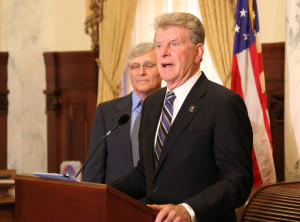Half of Idaho’s 2014 high school graduates are going on to college so far, casting doubt on whether the state will reach its 60-percent go-on goal.
According to data sets released Friday by the State Board of Education, 50.2 percent of the members of the 2014 graduating class were enrolled in a two- or four-year college 12 months after graduation.

For the past five years, Idaho lawmakers, Gov. Butch Otter and education policymakers have touted the state’s 60 percent go-on goal. That benchmark calls for 60 percent of Idaho’s 25- to 34-year-olds to earn a postsecondary degree or certificate by 2020.
Proponents have said the goal is an essential component to boosting the state’s economy and preparing students for life in the 21st Century.
According to the most recent go-on numbers, just 20 of the state’s 115 school districts and one charter school posted go-rates of 60 percent or better one year after graduation (Click the link for a district-by-district breakdown of the numbers: (Go-On Rates 2015). Numbers for small districts with fewer than 10 students enrolled in college were redacted in an effort to protect student privacy, in line with existing state policy on data privacy.
Because the numbers were collected one year after graduation, they may improve slightly as time goes on and students who complete a religious mission or take a year off to work and save money for their education enroll in college.
But students from the class of 2014 may not make a big difference in the state’s 60 percent go-on goal, because of their age and the way the goal is spelled out.
Many 2014 grads were 17 or 18 when they graduated just over a year ago, which would make them 18 and 19 today. In five more years, when the deadline for the 60 percent go-on goal rolls around, they will be 23 and 24, and not fall within the 25- to 34-year-old age range specifically spelled out in the goal.
This time last year, the National Student Clearinghouse put Idaho’s go-on rate for the class of 2013 at just below 52 percent – although that number captured student data 16 months after graduation, so it cannot be directly compared to this year’s data. The National Student Clearinghouse put the state’s go-on rate for the class of 2012 at 54 percent, again relying on data captured 16 months after those students graduated.
A study of 2010 numbers by the National Center for Higher Education Management Systems found that Idaho ranked last in the country in terms of high school graduates going on to college.

In January of this year, business executive Bob Lokken of WhiteCloud Analytics told members of the House Eduction Committee that the state was unlikely to meet its 60-percent go-on goal by 2020, although he said the goal was worthy and should not be abandoned.
“If you look at the numbers, you would be hard-pressed to figure out (how) we are going to get there in 2020,” Lokken said Jan. 22. “It truly would require some magic pill.”
Lokken further stressed that Idaho policymakers and educators need to shift from a “compliance mindset” to an “achievement mindset” if they hope to make progress towards the goals.
State Board of Education spokesman Blake Youde said board members are promoting a series of programs designed to help the state reach the go-on goal, including dual credit, the advanced opportunities program, a college and career advising program and the forthcoming Next Steps Idaho Campaign, which will help students, families and advisors plan and schedule out the steps students should take to prepare for college.
Next Steps Idaho is scheduled to launch a web-based campaign later this summer.
“We are continuing on with these initiatives because we know they will contribute to increasing the go-on rate in Idaho and heading toward that 60 percent goal,” Youde said. “There are a lot of strategies in place that work together, they are not all single strategies.”
